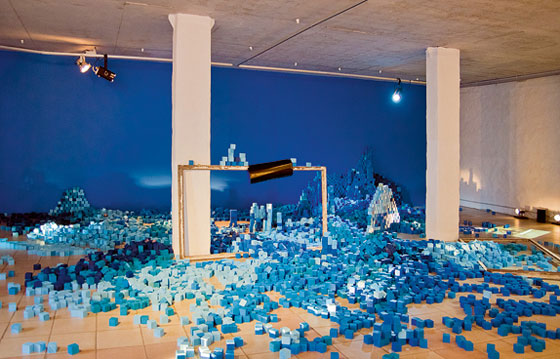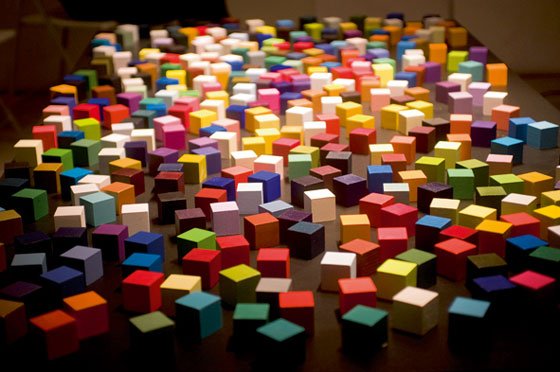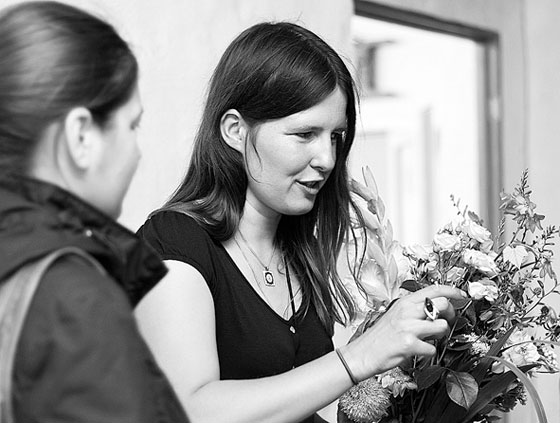|
|
| A place to think and a place to work Laine Kristberga, Film and Art Historian A conversation with the artist Laura Prikule | |
| Laura Prikule is a multidisciplinary artist working in the field of painting, photography, video art, installation and performance; besides, one medium does not exclude the other. In 2009, Prikule started the Poetic Robotism series of projects together with artist Eva Vēvere. Currently this consists of six episodes and geographically covers the entire Baltic region. The aim of Poetic Robotism is to conduct visual research, trying to find a balance between the poetic and the robotic, between system and freedom, the ideal and the actual. The medium chosen to reveal the core principles of Poetic Robotism is a hexahedron, or simply – a cube. A geometric feeling of time and space is also evident in other works by Laura. Laine Kristberga: You obtained a master’s degree at the San Francisco Institute of Art. Would it be appropriate to say that the years spent in California were your formative years? Was it the turning point to move away from painting, to start using other media and blurring the borders? Laura Prikule: There were very radical changes in the entire process. But mostly it affected my way of thinking. There had already been certain attempts to extend the means of expression earlier: a few objects in the openair show at Pedvāle and photography studies with Andrejs Grants. Still, a more conceptual approach to work developed during the final terms of study in San Francisco. L.K.: Knowing about Andrejs Grants’ attitude towards the subject – trying to take a snapshot of nothing in particular – what was it in photography that appealed to you? L.P.: An opportunity to combine going for walks in the external space with a kind of analysis of inner, subjective space. Though I don’t think I defined it that way at the time. It was more of a spontaneous and unconscious process in the beginning. Yet it was very necessary. | |
 Laura Prikule, Eva Vēvere. The projects of 'Poetic Robotism'. 6th episode: 'Aquatopia'. Interactive installation. View of the exhibition. Contemporary Art Cenrte kim?. 2011 | |
| L.K.: You have several photographic works – for instance, the work NY Streets (2010), where manhole covers and road markings intertwine in geometric poetry. Or the photo installation On the road (2010), which depicts the layers of cultural residue, or simply photographs taken as travel sketches and diary notes, for example, the fragile and lonely figure of a boy selling pink candyfloss against the background of powerful ocean waves in the Bay of Bengal. Is it the visual symbolism or the manipulation and artificial playfulness that are important for you in photography? L.P.: For me, the most important thing is to crop out the relevant idea from reality. It is crucial to hit the right spot and to take out only the barest minimum, in order to keep the message clear. L.K.: Apart from photography, you also use video in your works. What is the difference between the moving and the still image in delivering the message? L.P.: The element of time. The subject of time has always fascinated me. I have analysed it reflexively, too. For example, during the performance which took place in the fifth episode of Poetic Robotism, I felt that there is another rhythm of time which I can become part of. As the tempo of the performance accelerated, the feeling of real time got lost. Whereas in the realm of the still image different rules of time apply. L.K.: It reminds me of a recently read interview with the interdisciplinary artist Tagny Duff, who works somewhere between performance art, molecular biology and the history of science. Duff states that through working in bioart she has become aware of other thresholds of time, which cannot be equated to the human scale of time. There is always the potential that the biomaterial will outlive the artist. L.P.: The impact of nonlinear time is quite abundantly articulated in the world of art. There are periods when you read and write, there are periods when ideas materialise. Then you do the same things all over again. It’s the same, yet different. As in exhaling and inhaling. I personally need a place to think and a place to work (laughing). This studio in the VEF factory is a place to work – it is convenient for large-scale projects, you can use a freight elevator here and you don’t have to worry about the neighbours or the noise. Still, sometimes I have the feeling that for a deeper thinking process I need a completely empty space – it could be a clean, white cube, where I could concentrate on one idea at a time. L.K.: Could it be the white cube you talk about in your short story ‘Real and Ideal’? L.P.: In the story the white cube was more like a trap for perfectionists and idealists. It actually contained a good degree of irony. However, I wouldn’t deny that there is a certain temptation to build a cube like that on the beach one day. L.K.: The story also features the black cube, where one can come eye-to-eye with “everything, starting with stress, paranoia and distant childhood memories and ending with almost real monsters and demons”. Yet it is also emphasised that the black cube is in no way a prison, cemetery or a memorial of ideas – rather it is being used as a laboratory. Wasn’t this idea also reflected in the third installation of Poetic Robotism, created in September, 2010, as part of Survival Kit II at VEF? L.P.: The visual work consisted of two massive cubes: the white and the black. 288 smaller cubes and the same number of flowerpots were placed inside the cubes. In one of the cubes everything was set out in perfect order, in the other one (the white one) – in total chaos. I wrote the story afterwards, turning upside down the countdown scheme offered in the exhibition I die (I live), which was another joint work with Eva Vēvere. | |
 Laura Prikule, Eva Vēvere. The projects of 'Poetic Robotism'. 1st episode: 'Time Manager'. Interactive installation. View of the exhibition 'Underground Tourney' at Gallery 21. 2009 | |
| L.K.: Thinking of the concept of time, in Aquatopia – the latest episode of Poetic Robotism – you also consider time in various thresholds. While looking at the installation at the gallery space, the viewer finds himself at the given time and space. Whereas the video projection has its own lifespan, independent of real time, moreover it shows the leftovers of civilisation in a former toy factory in Tallinn… L.P.: And on the opposite wall you can see artefacts from the former VEF factory, which is yet another layer of time. In this work the viewer’s experience changes, depending on the location, and in general the work anticipates uncontrollable changes (laughing). It is essential that the water flow consisting of the numerous hexahedrons is never one and the same. In fact, along with the subject of time, the subject of freedom is also being investigated: how things change and merge, and all borders are illusory. To paraphrase: you cannot step in the same hexahedron river twice and each wave of cubes flows differently! The viewer, too, is offered the freedom to construct concrete systems from small elements, however there is also a choice not to build, or to demolish existing constructions. The colossal mass of cubes (around 18 000 units) provides the opportunity to construct something previously unplanned. L.K.: Do you document the shifts in the ‘sea of cubes’? L.P.: Not each day, but every now and then, yes. The last time I was at kim? there was a group of 20 people assembling something at the same time. And that again is a different experience for the viewer, as opposed to being there on one’s own. Everything keeps on radically transforming in this work and through the interactive engagement of viewers, new geometric structures appear every time. L.K.: Perhaps each separate cube contrasted against the mass of cubes can be viewed through the prism of ‘fragment and wholeness’? L.P.: Yes, quite definitely. It can be viewed, for instance, in the context of the individual and the state, asking whether an individual can identify with a state. L.K.: And what about yourself? Is there a feeling of belonging to Latvia, or, having had the San Francisco experience, you would rather identify yourself with America? L.P.: I guess it’s something else again. Despite a certain degree of patriotic feeling, the state as a phenomenon has always seemed to me too much an abstract entity to be able to identify with it. There are definite things well-understood in the Latvian context, for example, Latvian winter and the thick layer of snow that erases all forms is a typical local phenomenon. When I am abroad, Latvian winter and the slowing-down of time related to it is something I long for. Yet at times Latvia can be a true challenge to face. That’s when the USA experience comes in handy – how to make things possible, or refusing to see obstacles where they don’t even exist. To me, it is important to be aware of and document my feelings in various locations, and not to become attached to one particular mode of perception. Still, there are many situations when I apply a kind of ‘Californian perspective’. Or benchmark. Especially if it’s related to art. | |
 Laura Prikule. 2011 Foto: Baiba Zemgaliete | |
| L.K.: Maybe there is some kind of third space where you exist and where it is not possible to specify belonging to a certain nationality? L.P.: If we assume that there is both a vertical and horizontal feeling of space, then there are things that happen on the vertical axis, but the horizontal factor or the geographical location is merely something complementary. In different places all over the world you can feel the unifying factor among the differences. As one such example I could mention the Himalayas and New York. Both totally different locations, yet both have such a powerful charge of energy that it literally overwhelms you. L.K.: And what about belonging to a particular gender – does being a woman artist change anything in conveying your message? L.P.: There must be differences in the way women and men think. Just as a person is affected by the place he or she was born, where they grew up, the people met on the way, likewise belonging to a particular sex affects him or her to a certain degree. L.K.: The themes you explore are universal and not really located within the framework of one gender or the other. L.P.: Yes, I think that this sort of categorisation should be avoided. The way a viewer looks and what perspective he or she uses to look at a work of art at a definite moment in time is their business. L.K.: The French philosopher Michel de Certeau has noticed an interesting coincidence: in Athens, mass transportation vehicles are called metaphorai. In order to get to work or to come home, one has to use a ‘metaphor’ – a bus or a train. You, too, are interested in a closer examination of trajectories, moving from one point to another and in the mutual systems such trajectories form. This can be observed in your works Events (2009) and Mapping 2 (2009). L.P.: Most likely I simply like moving around, and sometimes I happen to document it. L.K.: In your work Network (2009) the mapping idea is also evident. This work resonates with the work Flight Patterns (2008) by Californian digital artist Aaron Koblin, where Koblin visualised USA aviation data, producing interesting animations as a result. Koblin notes that by “looking at something ordinary from a different point of view, we can make it extraordinary”. Is this something you too try to do, to construct a different perspective on a well-known reality? L.P.: This work intentionally has not been made digital. The lines on the black canvas were drawn with a piece of chalk, emphasizing the materiality of chalk as a substance. One of the visual lines of thought that I am interested in is to comment on digital phenomena using analogue methods. This principle is also in evidence in the Poetic Robotism episodes. L.K.: And in what way do you make visible your ideas? L.P.: During my Cité residency in Paris two years ago, I felt that every day I should document ideas on a specific spectrum of subjects. This gave rise to whole series of sketches. Later on, retrospectively, when looking at these drawings of ideas as well as the finished works in space, it is interesting to observe how the scale has changed and the idea has attracted the necessary medium; the fragments of thoughts have come together in mutually related visual structures. But at the bottom of it the visualization of ideas is a question of focussing. If I succeed in concentrating on an idea long enough, “without changing the subject”, the idea sooner or later finds its way of materialising. For this purpose, I use a variety of techniques – from a walk in the street to fragmentary phone conversations. Sometimes it can happen that I understand the idea only when the work is finished. Laura Prikule (born 1977) obtained a bachelor’s degree in Painting at the Latvian Academy of Art (LAA) and then studied at the San Francisco Institute of Art for three years as a Fulbright scholar. After graduation Prikule returned to Latvia, and is currently working on a doctoral thesis ‘The Creative Process and Transformation: Art in New York 1956-1973’ at the LAA. Laura Prikule’s works have been exhibited in Latvia and abroad. She has participated in the Survival Kit I and Survival Kit II projects organised by the Latvian Centre for Contemporary Art as well as exhibitions at VEF, the Interformat Symposium in Nida, Lithuania, Performance Art Now Vol.2 in Tallinn, Estonia, and others. Aquatopia, a joint project by Laura Prikule and Eva Vēvere and part of the Poetic Robotism series, is on show at the Contemporary Art Centre kim? until 18 September. /Translator into English: Laine Kristberga/ | |
| go back | |







